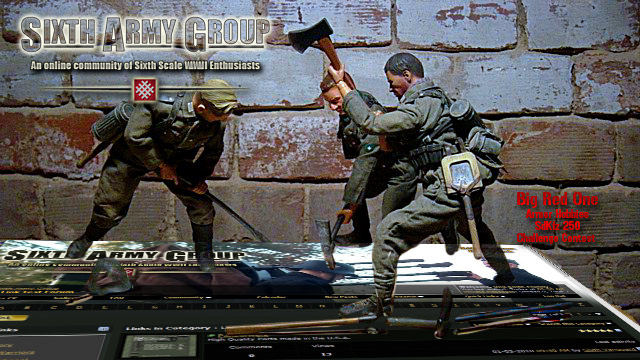Tony Barton
Company Commander
Mary Rose Archer.
An English bowman from the wreck of the Mary Rose of 1545 , based on the archaeological finds.
The new Museum containing the ship and contents has recently opened at Portsmouth , and I for one hope to visit soon.
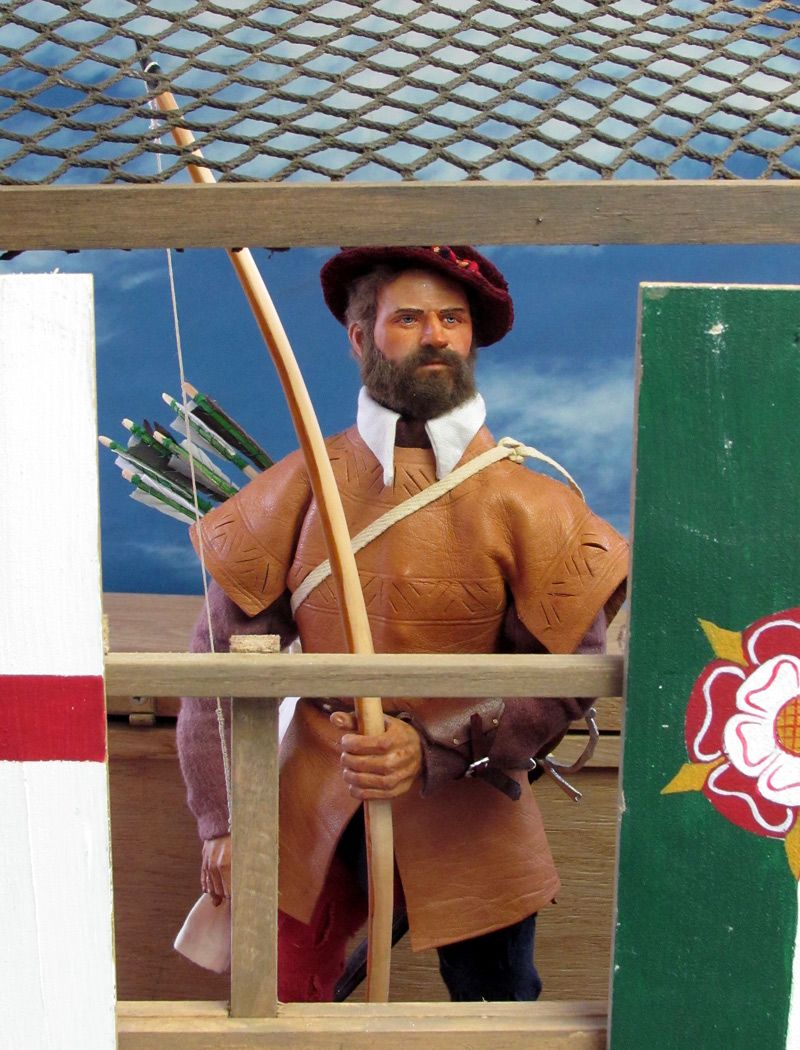

That's the contemporary painting of the ship from the Anthony Roll.
I’ve followed the whole astonishing project since it started in the 80s, and have actually helped reconstruct this fellow in 1:1 already.

Thanks to John and Jonathan Waller for the pic.
Until this epic find, the real nature of the English medieval bow was a mystery, since there were no survivors. There was a lot of misty-eyed nationalistic tosh ( there still is ) but no-one knew what they were really like.
The recovery of 137 intact bows, and a lot of arrows, has clarified the whole subject wonderfully, and there is now a thriving group of heroes shooting replicas : the English Warbow Society .
As an ex-archer myself I have always taken a keen interest in the whole topic, and only wish that I could still physically manage to shoot.
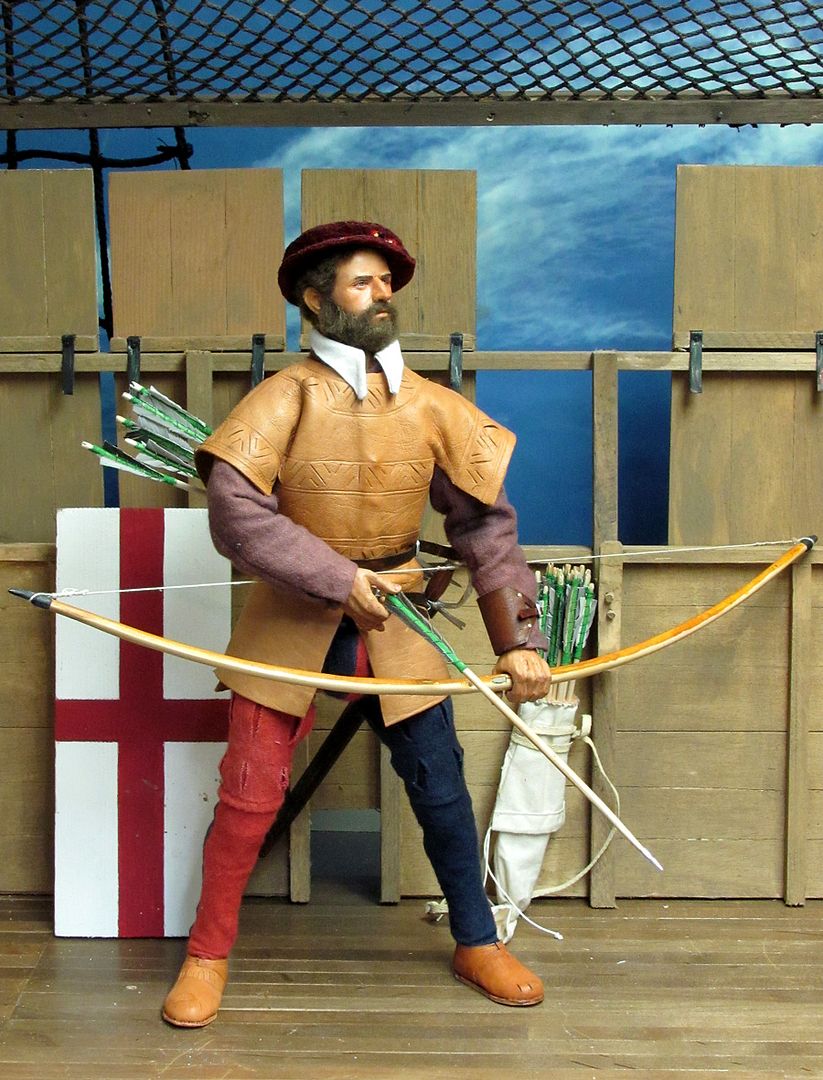
The wreck provided more than just bows. The surviving arrows were headless and flightless, but they were stowed in leather discs, allowing a clear picture of how they were handled in numbers and issued : in sheaves of 24, in “ clips” if you like . There were also bracers, several leather jerkins, shoes, and even the skeletal remains of archers have now been identified by the damage they inflicted on their shoulder bones and necks.

Archery was in its final glory in the 1540s.
The Battle of Pinkie in 1547 was pretty well the last major field where it was significant. It continued in use at sea until 1600, but on land firearms, which could be used effectively by any starveling boy trained for a couple of hours, were taking over. A bowman took years of physical training to produce, and they were proud specialists demanding respect and proper pay, which they got.
The physical part was crucial.

The draw-weights of medieval bows had long been speculated on , but the MR finds settled the matter. Most of them are between 90 and 130 lb, with some heavier bows up to 160 or more amongst them. To draw these repeatedly and accurately needed real strength and technique, like that acquired by weightlifters , and constant practice. Most recreational longbow archers today draw 40 to 50 lbs, and even that needs practice if you are to avoid hurting yourself.
So archers were big men , well fed and astoundingly strong .
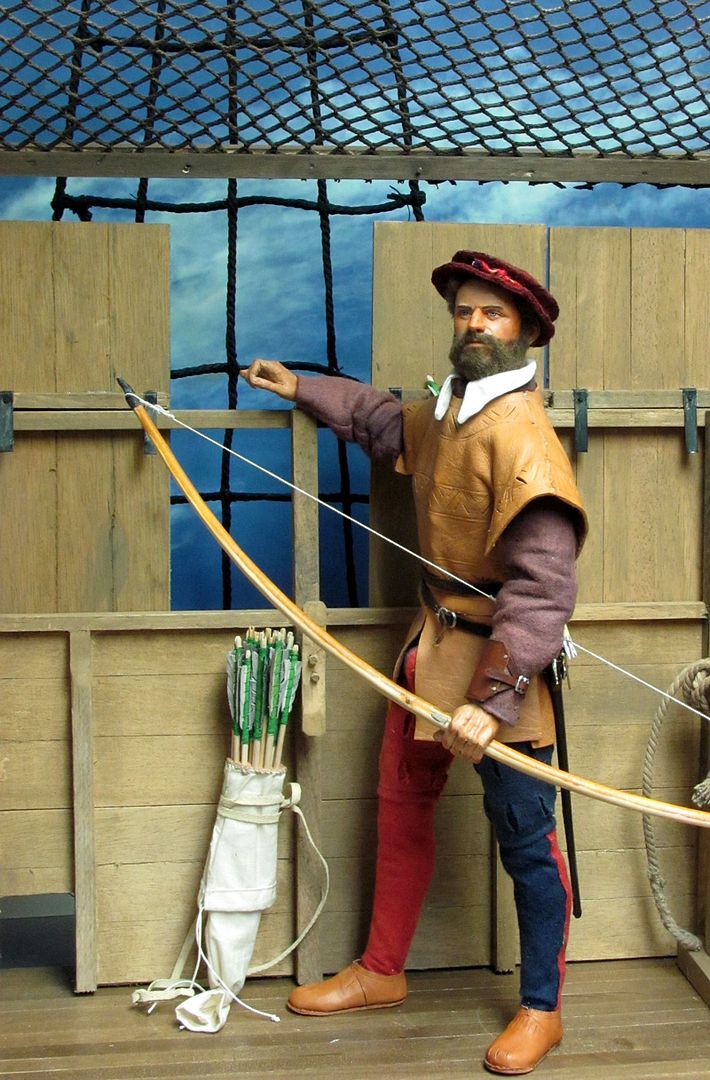
On shipboard their role was to clear the decks and tops of opposing ships, and to shoot fire arrows, a crucial weapon at sea. The very heavy bows found on the MR might have been used for that job in particular, because a fire arrow can be a heavy missile .
The Figure:
The body is some HT clone, quite heavily built, though they would not have looked like modern bodybuilders . The “ walnuts-in-a-condom” appearance so beloved of modern media is all cosmetic , a fantasy fuelled by cartoons ( and steroids ), and has not much to do with strength. The strongest man I have ever met was big, but not notably muscular . Four of us helped him pick up a stone slab weighing about 300 lbs and watched him carry it out to a van….
He’s wearing a shirt ( linen ) with a collar with long points,the latest style ; a doublet of purplish brown, and some bicoloured hose.The Vanguard of the army that went to France during this war wore hose in these colours, but whether the archers on board were uniformed is not known.The hose are the normal sort worn between 1500 and about 1550, with” upper stocks and nether stocks “tailored separately, sewn together above the knee . The uppers are made from three layers decorated with slashing.
The shoes are copied from the numerous pairs found on board : I have a pair myself .The leather jerkin is a reconstruction from the rather fragmentary finds , made from a Morrocco handbag . The hat is a knitted bonnet moulded from felt. He doesn’t wear armour, since it’s a handicap on shipboard, though much was still worn on land. The bulwarks of the ship provided protection enough.

The bow is made from yew.
Alas, I can’t find a piece of the right size with heartwood and sapwood like the originals, so I’ve painted it to get the two-colour effect. It was undoubtedly the best wood, and has been used for bows since the Neolithic. In fact , the yew bow design has scarcely changed since then , though the late medieval examples are heavier.
Mine works : it will shoot an arrow about 20 feet.


The arrows from barbecue skewers, tapered and fletched with pigeon feathers, and fitted with cast bodkin heads.
The green colour is from the glue coloured with verdigris used to hold the feathers on , thought to have been protection against vermin in stored arrows.
One problem with having a working miniature bow is that the figure is not quite up to the job of drawing it : it’s rather stronger than he is ! I have reduced its draw-weight as far as possible to accommodate him, but he can’t hold it at full draw long enough for a pic.

His arrows are carried in an arrow bag, reconstructed from the surviving leather discs on the MR and early drawings . The leather disc keeps the fletchings separate, the linen bag is waxed to keep them dry. The sheaves of 24 arrows might have been issued in these, but we can’t be sure, and maybe they were just in bundles in the dics alone.He has some taken out and stuck in his belt, which is always the easiest way to hold them when shooting.
His sword is a simple , early type of knucklebow hilt.
He wouldn’t need to carry a cloak , snapsack nor waterbottle since he’s on shipboard .
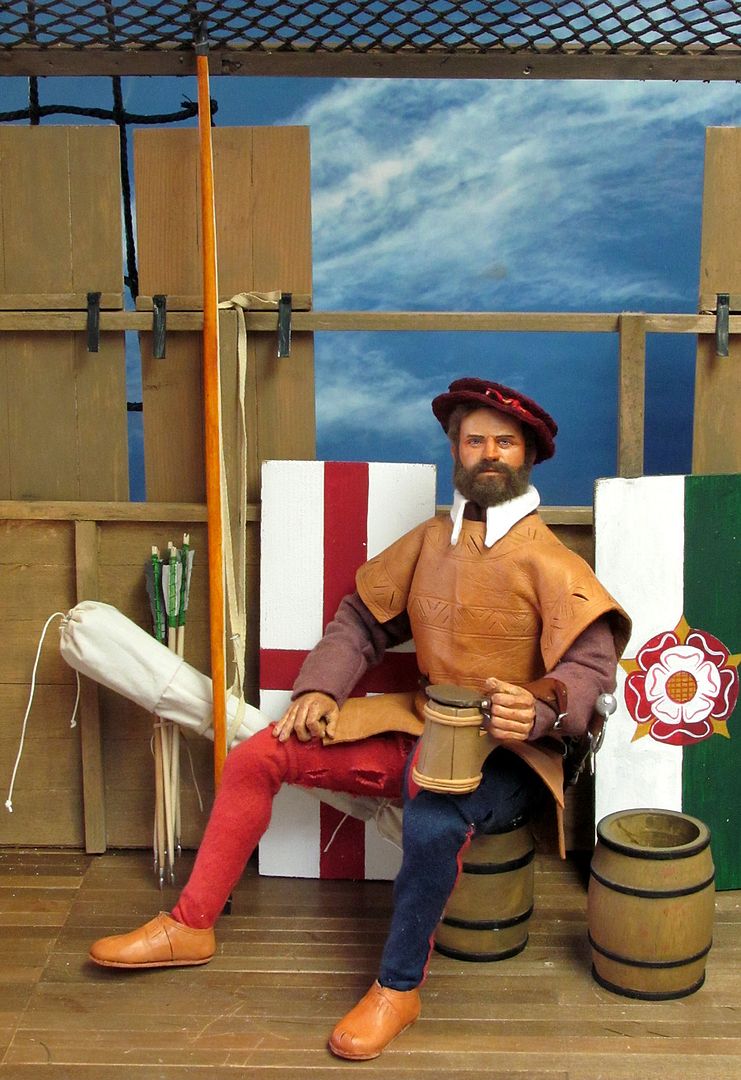
The set is just an impression : I make no attempt at precise accuracy, since I don’t have any detailed information. The upper parts of the ship didn’t survive, but doubtless someone somewhere has done a plausible reconstruction .In paintings, the upper decks are shown bordered by rows of pavises painted with heraldic badges. The overhead anti-boarding nets were fitted on the evil day , and contributed greatly to the casualties by trapping men when she went down .
The Mary Rose was in brand spanking-new clean condition , have just come from harbour having been rebuilt, with the addition of new gunports. She only made it a few miles before flooding though a lower gunport and sinking in moments.
An appalling tragedy in 1545 , but a glorious gift to us now.
****************************************************************************
An English bowman from the wreck of the Mary Rose of 1545 , based on the archaeological finds.
The new Museum containing the ship and contents has recently opened at Portsmouth , and I for one hope to visit soon.


That's the contemporary painting of the ship from the Anthony Roll.
I’ve followed the whole astonishing project since it started in the 80s, and have actually helped reconstruct this fellow in 1:1 already.

Thanks to John and Jonathan Waller for the pic.
Until this epic find, the real nature of the English medieval bow was a mystery, since there were no survivors. There was a lot of misty-eyed nationalistic tosh ( there still is ) but no-one knew what they were really like.
The recovery of 137 intact bows, and a lot of arrows, has clarified the whole subject wonderfully, and there is now a thriving group of heroes shooting replicas : the English Warbow Society .
As an ex-archer myself I have always taken a keen interest in the whole topic, and only wish that I could still physically manage to shoot.

The wreck provided more than just bows. The surviving arrows were headless and flightless, but they were stowed in leather discs, allowing a clear picture of how they were handled in numbers and issued : in sheaves of 24, in “ clips” if you like . There were also bracers, several leather jerkins, shoes, and even the skeletal remains of archers have now been identified by the damage they inflicted on their shoulder bones and necks.

Archery was in its final glory in the 1540s.
The Battle of Pinkie in 1547 was pretty well the last major field where it was significant. It continued in use at sea until 1600, but on land firearms, which could be used effectively by any starveling boy trained for a couple of hours, were taking over. A bowman took years of physical training to produce, and they were proud specialists demanding respect and proper pay, which they got.
The physical part was crucial.

The draw-weights of medieval bows had long been speculated on , but the MR finds settled the matter. Most of them are between 90 and 130 lb, with some heavier bows up to 160 or more amongst them. To draw these repeatedly and accurately needed real strength and technique, like that acquired by weightlifters , and constant practice. Most recreational longbow archers today draw 40 to 50 lbs, and even that needs practice if you are to avoid hurting yourself.
So archers were big men , well fed and astoundingly strong .

On shipboard their role was to clear the decks and tops of opposing ships, and to shoot fire arrows, a crucial weapon at sea. The very heavy bows found on the MR might have been used for that job in particular, because a fire arrow can be a heavy missile .
The Figure:
The body is some HT clone, quite heavily built, though they would not have looked like modern bodybuilders . The “ walnuts-in-a-condom” appearance so beloved of modern media is all cosmetic , a fantasy fuelled by cartoons ( and steroids ), and has not much to do with strength. The strongest man I have ever met was big, but not notably muscular . Four of us helped him pick up a stone slab weighing about 300 lbs and watched him carry it out to a van….
He’s wearing a shirt ( linen ) with a collar with long points,the latest style ; a doublet of purplish brown, and some bicoloured hose.The Vanguard of the army that went to France during this war wore hose in these colours, but whether the archers on board were uniformed is not known.The hose are the normal sort worn between 1500 and about 1550, with” upper stocks and nether stocks “tailored separately, sewn together above the knee . The uppers are made from three layers decorated with slashing.
The shoes are copied from the numerous pairs found on board : I have a pair myself .The leather jerkin is a reconstruction from the rather fragmentary finds , made from a Morrocco handbag . The hat is a knitted bonnet moulded from felt. He doesn’t wear armour, since it’s a handicap on shipboard, though much was still worn on land. The bulwarks of the ship provided protection enough.

The bow is made from yew.
Alas, I can’t find a piece of the right size with heartwood and sapwood like the originals, so I’ve painted it to get the two-colour effect. It was undoubtedly the best wood, and has been used for bows since the Neolithic. In fact , the yew bow design has scarcely changed since then , though the late medieval examples are heavier.
Mine works : it will shoot an arrow about 20 feet.


The arrows from barbecue skewers, tapered and fletched with pigeon feathers, and fitted with cast bodkin heads.
The green colour is from the glue coloured with verdigris used to hold the feathers on , thought to have been protection against vermin in stored arrows.
One problem with having a working miniature bow is that the figure is not quite up to the job of drawing it : it’s rather stronger than he is ! I have reduced its draw-weight as far as possible to accommodate him, but he can’t hold it at full draw long enough for a pic.

His arrows are carried in an arrow bag, reconstructed from the surviving leather discs on the MR and early drawings . The leather disc keeps the fletchings separate, the linen bag is waxed to keep them dry. The sheaves of 24 arrows might have been issued in these, but we can’t be sure, and maybe they were just in bundles in the dics alone.He has some taken out and stuck in his belt, which is always the easiest way to hold them when shooting.
His sword is a simple , early type of knucklebow hilt.
He wouldn’t need to carry a cloak , snapsack nor waterbottle since he’s on shipboard .

The set is just an impression : I make no attempt at precise accuracy, since I don’t have any detailed information. The upper parts of the ship didn’t survive, but doubtless someone somewhere has done a plausible reconstruction .In paintings, the upper decks are shown bordered by rows of pavises painted with heraldic badges. The overhead anti-boarding nets were fitted on the evil day , and contributed greatly to the casualties by trapping men when she went down .
The Mary Rose was in brand spanking-new clean condition , have just come from harbour having been rebuilt, with the addition of new gunports. She only made it a few miles before flooding though a lower gunport and sinking in moments.
An appalling tragedy in 1545 , but a glorious gift to us now.
****************************************************************************
